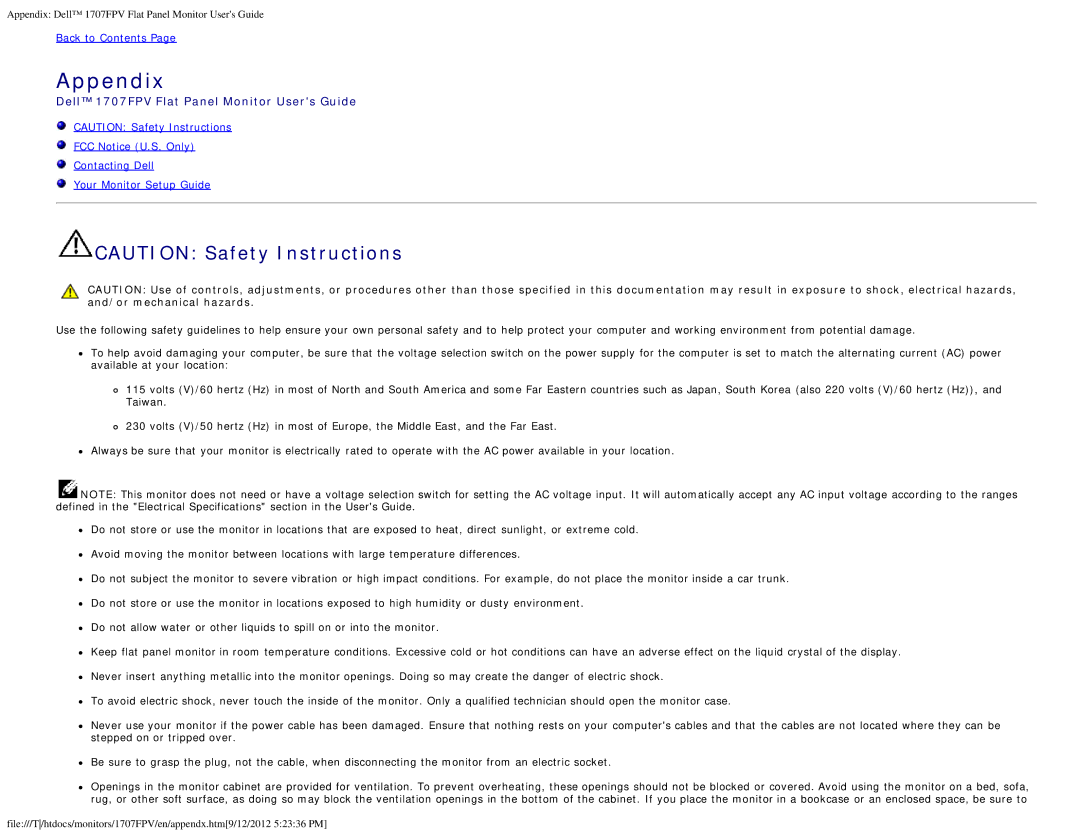
Appendix: Dell™ 1707FPV Flat Panel Monitor User's Guide
Back to Contents Page
Appendix
Dell™ 1707FPV Flat Panel Monitor User's Guide
![]() CAUTION: Safety Instructions
CAUTION: Safety Instructions
![]() FCC Notice (U.S. Only)
FCC Notice (U.S. Only)
![]() Contacting Dell
Contacting Dell
![]() Your Monitor Setup Guide
Your Monitor Setup Guide
![]() CAUTION: Safety Instructions
CAUTION: Safety Instructions
CAUTION: Use of controls, adjustments, or procedures other than those specified in this documentation may result in exposure to shock, electrical hazards, and/or mechanical hazards.
Use the following safety guidelines to help ensure your own personal safety and to help protect your computer and working environment from potential damage.
![]() To help avoid damaging your computer, be sure that the voltage selection switch on the power supply for the computer is set to match the alternating current (AC) power available at your location:
To help avoid damaging your computer, be sure that the voltage selection switch on the power supply for the computer is set to match the alternating current (AC) power available at your location:
![]() 115 volts (V)/60 hertz (Hz) in most of North and South America and some Far Eastern countries such as Japan, South Korea (also 220 volts (V)/60 hertz (Hz)), and Taiwan.
115 volts (V)/60 hertz (Hz) in most of North and South America and some Far Eastern countries such as Japan, South Korea (also 220 volts (V)/60 hertz (Hz)), and Taiwan.
![]() 230 volts (V)/50 hertz (Hz) in most of Europe, the Middle East, and the Far East.
230 volts (V)/50 hertz (Hz) in most of Europe, the Middle East, and the Far East.
![]() Always be sure that your monitor is electrically rated to operate with the AC power available in your location.
Always be sure that your monitor is electrically rated to operate with the AC power available in your location.
![]() NOTE: This monitor does not need or have a voltage selection switch for setting the AC voltage input. It will automatically accept any AC input voltage according to the ranges defined in the "Electrical Specifications" section in the User's Guide.
NOTE: This monitor does not need or have a voltage selection switch for setting the AC voltage input. It will automatically accept any AC input voltage according to the ranges defined in the "Electrical Specifications" section in the User's Guide.
Do not store or use the monitor in locations that are exposed to heat, direct sunlight, or extreme cold.
Avoid moving the monitor between locations with large temperature differences.
Do not subject the monitor to severe vibration or high impact conditions. For example, do not place the monitor inside a car trunk.
Do not store or use the monitor in locations exposed to high humidity or dusty environment.
![]() Do not allow water or other liquids to spill on or into the monitor.
Do not allow water or other liquids to spill on or into the monitor.
![]() Keep flat panel monitor in room temperature conditions. Excessive cold or hot conditions can have an adverse effect on the liquid crystal of the display.
Keep flat panel monitor in room temperature conditions. Excessive cold or hot conditions can have an adverse effect on the liquid crystal of the display.
Never insert anything metallic into the monitor openings. Doing so may create the danger of electric shock.
To avoid electric shock, never touch the inside of the monitor. Only a qualified technician should open the monitor case.
Never use your monitor if the power cable has been damaged. Ensure that nothing rests on your computer's cables and that the cables are not located where they can be stepped on or tripped over.
Be sure to grasp the plug, not the cable, when disconnecting the monitor from an electric socket.
![]() Openings in the monitor cabinet are provided for ventilation. To prevent overheating, these openings should not be blocked or covered. Avoid using the monitor on a bed, sofa, rug, or other soft surface, as doing so may block the ventilation openings in the bottom of the cabinet. If you place the monitor in a bookcase or an enclosed space, be sure to
Openings in the monitor cabinet are provided for ventilation. To prevent overheating, these openings should not be blocked or covered. Avoid using the monitor on a bed, sofa, rug, or other soft surface, as doing so may block the ventilation openings in the bottom of the cabinet. If you place the monitor in a bookcase or an enclosed space, be sure to
file:///T/htdocs/monitors/1707FPV/en/appendx.htm[9/12/2012 5:23:36 PM]
